|
It was early Saturday morning. It is getting hot during the day, so I
am trying to get out earlier. I am not sure it makes much difference to
the fish, but it sure does to the fisherman. This is a pond that I do
not get to very often. The landowner does not want me going in when
there are cattle on the pastures. Since I have to cross three pastures
to get to the pond, a deep gully prevents entry on the shorter route;
there are not many times that all three pastures are empty. This is one
of those times and the landowner calls me that I can go in. He is going
to be on the pond also, so he asks that I leave the gates open as I go
in so he can get in easier. He does not get out as early as I do.
I get in and get almost everything into the canoe. The missing item is
the camera. I do not yet have it ingrained into my head that the camera
is part of my fishing equipment. So, sorry there are no pictures of this
pond. I will try to put a note on the door to remember to bring the
camera. I just have to remember the note better than I do the camera.
This pond is about three acres in size. It is almost rectangular and
runs west to east. The deepest water is about 14 feet, near the middle
of the dam. Most of the water is less than eight feet deep. There is a
band of weeds that extends out about four feet from the shore all the
way around the pond. The pond is fenced so cattle do not get into it.
When the pond was built the landowner wanted a four-foot band around the
pond that was about two feet deep. The next pass was eight feet wide and
drops from the two-foot depth to about five feet deep. This pass did not
go across the dam. The rest of the land was left alone. There were
some stumps that were dug out and those were placed along the deep edge
of the second pass. Many of the limbs that came off the trees that were
in the area cleared to form the pond are also in the pond. This makes
great cover for the fish, but it is also a good place to loose a fly or
two.
I know where a few of the stumps are, having decorated them with flies
previously. That seems to be a good place to try the first casts. I
wonder if fish are relating to the stumps or if they are deeper in the
water. There is one way to find out.
I have four rods with me today. A 1-wt., two 3-wts, and a 5 wt. make up
the arsenal.
I have a white boa yarn leech, a peacock swordtail nymph, a gilly (see
the FOTW archives for the boa fly and Rick Favorites in the panfish
archives for the others) and a popper-midge combination on these rods.
The popper\midge goes out first and I let it sit. Are the fish
interested in the midge or the popper? This is a way to find out. I
cast the peacock swordtail nymph past the stump and bring it slowly
back. When the fly is near the stump I get a little nip. I try to set
the hook but nothing is on the line. Is this a day when I have to wait
longer to let the fish get the fly farther into their mouth? I will
check this out on the next cast. This time I let the fish nip it three
times before I try to set the hook. I have a fish on for a few seconds
and then it is gone.
I cast to the other side of the stump and let the fish nip four times
before I set the hook. I get this fish to the canoe before I loose it.
It was barely lip hooked and as I tried to swing it up the hook pulled
through the flesh of the lip. I am getting closer, but still do not have
a fish in the basket.
A few more casts convince me it is time to move. As I go down the
shoreline I am getting fish to hit every few feet. It is hard to land
them as they are just nipping at the fly, and if hooked it is just
barely in the lip. I drop down a size in the fly, 10 to 12, and it does
not make any difference. I am still just barely lip hooking them. But
I have become a little smarter. I am netting them and not trying to
swing them up into the canoe.
By this time the landowner is on the pond. He is casting for bass.
Even the bass seem to be just nipping at the fly. He gets several
strikes, but is not hooking many of the fish.
After almost two hours of fishing, I remember that I have a few flies
that just might work better in this situation. I have a great memory;
sometimes it just does not function very well. I had tied a few flies on
a long shank size 10 Aberdeen hook. This hook is about twice as long as
a regular size 10 hook is. I have read this at some time so it is not
original with me. I tie the fly the same size as the previous ones.
This means that the end of the tail extends to just beyond the
bend of the hook. If the fish are short striking, this might be
the solution.
I try this fly and it works better. I am hooking more of the fish and
getting a few more to the canoe. It might have worked better, if I had
tried it earlier in the day. As the sun gets higher the fish are not as
cooperative. I fish deeper and change flies, but nothing seems to help.
The thirst indicator tells me that it is time to leave. I have a water
bottle in the truck, but do not take it on the pond with me. I find
that at about three hours of fishing, I am thirsty. I do not wear a
watch while I am fishing, but this is my internal clock.
I head off the pond and the landowner decides to leave also. We both
get our boats out of the water and loaded at about the same time. It
makes it nice going through the gates as we leapfrog each other. When
we get to the main road I ask him if he wants some fish. He says he
would like some, but he does not know how to fillet them. He has a knife
and a board, so it is time for a lesson. I do two fish and then have
him do a few. He gets them done and decides that this is not hard to
do.
I did not give him the lone crappie that I caught. I also had 25
bluegills in the basket, excluding those I gave to the landowner. I
should be able to get back into this pond in about five weeks.
Hopefully by then I will remember to bring the camera.
Hope you can get out on the water. ~ Rick
|



